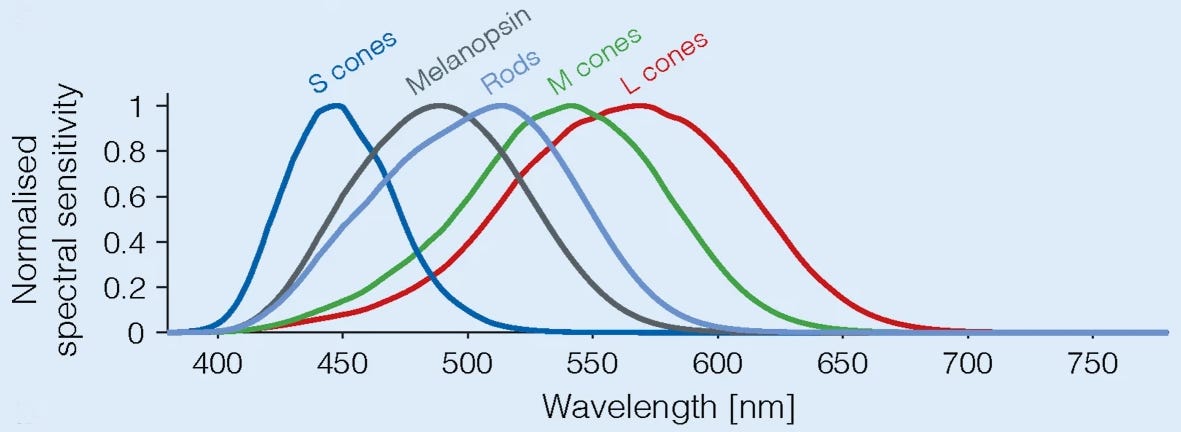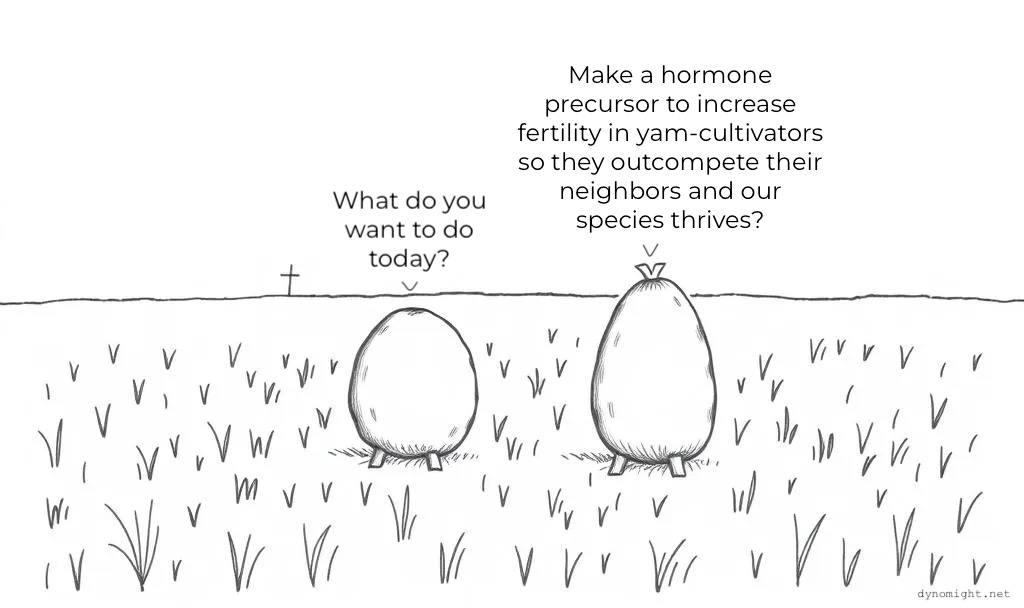dynomight.net/links-3 ← If you share this post, kindly use this URL.
Goats, like most hoofed mammals, have horizontal pupils.
[…]When a goat’s head tilts up (to look around) and down (to munch on grass), an amazing thing happens. The eyeballs actually rotate clockwise or counterclockwise within the eye socket. This keeps the pupils oriented to the horizontal.
[…]
To test out this theory, I took photos of Lucky the goat’s head in two different positions, down and up.
(2) Novel color via stimulation of individual photoreceptors at population scale (h/t Benny)
The cones in our eyes all have overlapping spectra. So even if you look at just a single frequency of light, more than one type of cone will be stimulated.
So, obviously, what we need to do is identify individual cone cell types on people’s retinas and then selectively stimulate them with lasers so that people can experience never-before-seen colors.
Attempting to activate M cones exclusively is shown to elicit a color beyond the natural human gamut, formally measured with color matching by human subjects. They describe the color as blue-green of unprecedented saturation.
When I was a kid and I was bored in class, I would sometimes close my eyes and try to think of a “new color”. I never succeeded, and in retrospect I think I have aphantasia.
But does this experiment suggest it is actually possible to imagine new colors? I’m fascinated that our brains have the ability to interpret these non-ecological signals, and applaud all such explorations of qualia space.
(3) Simplifying Melanopsin Metrology (h/t Chris & Alex)
When reading about blue-blocking glasses, I failed to discover that the effects of light on melatonin don’t seem to be mediated by cones or rods at all. Instead, around 1% of retinal photosensitive cells are melanopsin-containing retinal ganglion cells.
These seem to specifically exist for the purpose of regulating melatonin and circadian rhythms. They have their own spectral sensitivity:
If you believe that sleep is mediated entirely by these cells, then you’d probably want to block all frequencies above ~550 nm. That would leave you with basically only orange and red light.
However, Chris convinced me that if you want natural melatonin at night, the smart thing is primarily rely on dim lighting, and only secondarily on blocking blue light. Standard “warm” 2700 K bulbs only reduce blue light to around ⅓ as much. But your eyes can easily adapt to <10% as many lux. If you combine those, blue light is down by ~97%.
The brain doesn’t seem to use these cells for pattern vision at all. Although…
In work by Zaidi, Lockley and co-authors using a rodless, coneless human, it was found that a very intense 481 nm stimulus led to some conscious light perception, meaning that some rudimentary vision was realized.
Airplanes have to guess how much food to bring. So either they waste energy moving around extra food that no one eats, or some people go hungry. So why don’t we have people bid on food, so nothing goes to waste?
I expect passengers would absolutely hate it.
(5) The Good Sides Of Nepotism
Speaking of things people hate, this post gives a theory for why you might rationally prefer to apply nepotism when hiring someone: Your social connections increase the cost of failure for the person you hire. I suspect we instinctively apply this kind of game theory without even realizing we’re doing so.
This seems increasingly important, what with all the AI-generated job applications now attacking AI-automated human resources departments.
My question is: If this theory is correct, can we create other social structures to provide the same benefit in other ways, therefore reducing the returns on nepotism?
Say I want you to hire me, but you’re worried I suck. In principle, I could take $50,000, put it in escrow, and tell you, “If you hire me, and I actually suck (as judged by an arbiter) then you can burn the $50,000.”
Sounds horrible, right? But that’s approximately what’s happening if you know I have social connections and/or reputation that will be damaged if I screw up.
We’ve spent decades in the dark ages of the internet, where you could only link to entire webpages or (maybe) particular hidden beacon codes.
But we are now in a new age. You can link to any text on any page. Like this:
https://dynomight.net/grug#:~:text=phenylalanine
This is not a special feature of dynomight.net. It’s done by your browser.
I love this, but I can never remember how to type #:~:text=. Well, finally, almost all browsers now also support generating these links. You just highlight some text, right-click, and “Copy Link to Highlight”.
If you go to this page and highlight and right-click on this text:
Then you get this link.
This works out of the box in Safari and Chrome-esque browsers. In Firefox (from my cold, dead hands) you currently have to edit a preference.
(7) (Not technically a link)
Also, did you know you can link to specific pages of pdf files? For example:
https://gwern.net/doc/longevity/glp/semaglutide/2023-aroda.pdf#page=8
I just add #page= manually. Chrome-esque browsers, oddly, will do automatically if you right-click and go to “Create QR Code for this Page”.
(8) Response to Dynomight on Scribble-based Forecasting
Thoughtful counter to some of my math skepticism. I particularly endorse the point in the final paragraph.
(9) Decision Conditional Prices Reflect Causal Chances
Robin Hanson counters my post on Futarchy’s fundamental flaw. My candid opinion is that this is a paradigmatic example of a “heat mirage”, in that he doesn’t engage with any of the details of my argument, doesn’t specify what errors I supposedly made, and doesn’t seem to commit to any specific assumptions that he’s willing to argue are plausible and would guarantee prices that reflect causal effects. So I don’t really see any way to continue the conversation. But judge for yourself!
(10) Futarchy’s fundamental flaw - the market
Speaking of which, Bolton Bailey set up a conditional prediction market to experimentally test one of the examples I gave where I claimed prediction markets would not reflect causal probabilities.
If you think betting on causal effects is always the right strategy in conditional prediction markets, here’s your chance to make some fake internet currency. The market closes on July 26, 2025. No matter how much you love me, please trade according to your self-interest.
(11) War and Peace
I’m reading War and Peace. You probably haven’t heard, but it’s really good.
Except the names. Good god, the names. There are a lot of characters, and all the major ones have many names:
Andréy
Nikoláevich
Bolkónski
Andrúsha
André
Prince Andréy
Prince Bolkónski
Prince Andréy Nikoláevich
Those are all the same person. Try keeping track of all those variants for 100 different characters in a narrative with many threads spanning time and space. Sometimes, the same name refers to different people. And Tolstoy loves to just write “The Princess” when there are three different princesses in the room.
So I thought, why not use color? Whenever a new character appears, assign them a color, and use it for all name variants for the rest of the text. Even better would be to use color patterns like Bolkónski / Prince Andréy Nikoláevich.
This should be easy for AI, right?
I can think of ways to do this, but they would all be painful, due to War and Peace’s length: They involve splitting the text into chunks, having the AI iterate over them while updating some name/color mapping, and then merging everything at the end.
So here’s a challenge: Do you know an easy way to do this? Is there any existing tool that you can give a short description of my goals, and get a full name-colored pdf / html / epub file? (“If your agent cannot do this, then of what use is the agent?”)
Note: It’s critical to give all characters a color. Otherwise, seeing a name without color would be a huge spoiler that they aren’t going to survive very long. It’s OK if some colors are similar.
There’s also the issue of all the intermingled French. But I find that hard not to admire—Tolstoy was not falling for audience capture.
(And yes, War and Peace, Simplified Names Edition apparently exists. But I’m in too deep to switch now.)
(12) Twins
The human twin birth rate in the United States rose 76% from 1980 through 2009, from 9.4 to 16.7 twin sets (18.8 to 33.3 twins) per 1,000 births. The Yoruba people have the highest rate of twinning in the world, at 45–50 twin sets (90–100 twins) per 1,000 live births possibly because of high consumption of a specific type of yam containing a natural phytoestrogen which may stimulate the ovaries to release an egg from each side.
I love this because, like:
(That actually happened. Yams had that conversation and then started making phytoestrogens.)
Apparently, some yams naturally contain the plant hormone diosgenin, which can be chemically converted into various human hormones. And that’s actually how we used to make estrogen, testosterone, etc.
And if you like that, did you know that estrogen medications were historically made from the urine of pregnant mares? I thought this was awesome, but after reading a bit about how this worked, I doubt the horses would agree. Even earlier, animal ovaries and testes were used. These days, hormones tend to be synthesized without any animal or plant precursor.
If you’re skeptical that more twins would mean higher reproductive fitness, note that yams don’t believe in Algernon Arguments.






About seeing unusual colours, I suppose you’ve see these? No lasers required.
https://www.skytopia.com/project/illusion/ipage-et.html
The first solution to the name problem for my luddite brain is to copy paste it into a text document and make use of Find and Replace but that also would almost certainly be more trouble than it's worth.
Premarin is some of the most accessible pharmacy lore, the source is right there in the name! PREgnant MARe's urINe.